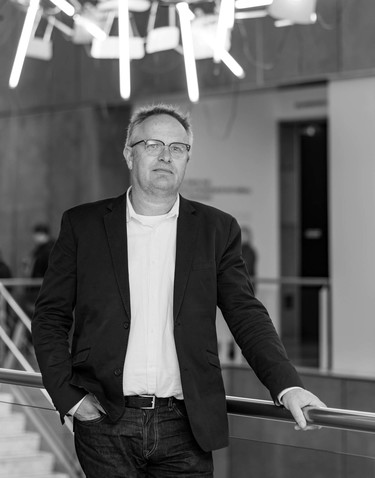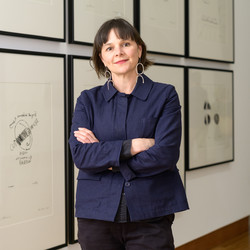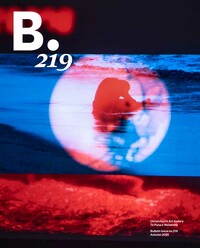
Becoming Someone Different
The Gallery’s new director, Blair Jackson, talks with Bulletin editor David Simpson about where he’s come from, what he’s got planned, and what he’s excited about as he settles in to his new role.
David Simpson: Do you think you can complete this interview without referring to the earthquakes?
Blair Jackson: Challenge accepted...
DS: You’ve been at the Gallery for nearly twelve years now – how does it feel to move into the role of director?
BJ: As I write this, I’ve only been in the job for four days. In that time I’ve moved office, been invited to multiple meetings, and interviewed, hugged, emailed and photographed more than I ever imagined possible. So, while there is a sense of the familiar – the building and the people I work with are the same – there is also that intense new job feeling (which I haven’t felt for quite a while). A sense of starting out once again, a new beginning.
Moving to a new job is one of these moments in life where you get to reinvent yourself. Whether it’s new clothes, a new haircut or a complete reinvention, it’s a moment when you can become someone different. That’s quite easy when you move cities or organisations but much more difficult when all you have done is walk thirty metres to a new office!
The job application process provided a real opportunity for me to reflect on the role of the Gallery in the context our changing city. It also gave me an opportunity to identify what would be important to me as the Gallery’s director. And for me, it’s about building our audiences – yes, increasing numbers, but more importantly, building a community that sees the Gallery as essential to living in this city. It’s about offering an experience that people want to return for again and again. I want people to see Christchurch as an incredibly creative place where the arts thrive and are integral to the city’s identity.
DS: Can you tell us about your background and how you started with the Gallery? When did you know this industry was a path you wanted to pursue?
BJ: I first arrived in Christchurch in 1984. I moved down from Napier as an 18-year-old to study at the University of Canterbury’s School of Fine Arts.
Life in Napier at the time was all about hanging out – surfers and stoners. The live music scene was mainly classic rock and blues bands (not that I was technically old enough to get into a pub back then). I was terrible at surfing. Luckily I had a couple of inspiring art teachers, and I loved the local art gallery and museum. Sometime in the early eighties the museum presented two touring exhibitions, Pat Hanly’s Painter as Printmaker, toured by the Wairarapa Art Centre, and the Sarjeant Gallery’s Philip Trusttum: Selected Works 1962–1979. I still think about the effect those two exhibitions had on me. The moment that the penny dropped and boom, I had a plan! I wanted to be an artist.
Arriving in Christchurch (my first time in the South Island) was mind-expanding. The music was new and intense and broke every rule that I had formulated as to what was cool (or not). There was an actual art gallery or two, dealer galleries, and most importantly a group of people who loved music as much as I did and also wanted to be artists.
In early November 1988, I finished art school with a BFA in painting. Quite by chance, at the same time the Canterbury Society of Arts was advertising for a gallery assistant.
The artist Joanna Braithwaite was working there and she taught me how to hang and pack paintings. It was a fast and furious environment but also a lot of fun. We changed out all the exhibitions across the entire building every two weeks. Two days for deinstalling and installing. A huge fortnightly opening on a Tuesday evening with gallons of lousy wine. Wednesday, wash the glasses, pack up the last shows and start again. Looking back, it was crazy but I learnt a lot. I got to meet so many artists, and what I loved was helping them install exhibitions and maybe helping to make things happen that they might not have considered or were unable to do by themselves.
My wife Kim and I left Christchurch in 1992 for a stint in Palmerston North with jobs at Manawatu Art Gallery and then the Science Centre and Manawatu Museum (and a couple of kids). Then came nine or so years in Dunedin working at both the Dunedin Public Art Gallery and the Otago Settlers Museum. My art-making slowed to a stop, and gallery life took over. To be honest we never really thought about moving back to Christchurch, but then in 2006 the opportunity to work with Jenny Harper and the new Christchurch Art Gallery came up and here I am.
DS: You’ve obviously been a big part of shaping the direction the Gallery has taken over the last decade. But what are your priorities for the Gallery now?
BJ: Looking back over my twelve years at Christchurch Art Gallery Te Puna o Waiwhetū, the one constant has been change. Whether that change was unplanned and forced upon us or not isn’t the point; I think it’s essential to continually refine what we are doing, make adjustments and keep an eye on what’s ahead. A gallery, or any organisation for that matter, should always be evolving, continually looking forward and adapting. It’s a dangerous thing to sit still and be complacent.
So the priorities for me are still the same, but it’s how we get there that we can fine-tune. My main priorities will always be our audience and the artists we work with. I’m keen to see us continuing to grow visitor numbers and get back to where we were heading pre-closure. But it’s not just about numbers; it’s about the quality and type of experiences that build those numbers. Working with artists, making great exhibitions and growing audiences go hand-in-hand.
The Gallery needs to offer a wide range of art experiences for a wide range of people. But audiences are changing; there’s now a demand for an experience that is more compelling and
involves an element of interactivity, from something as simple as the selfie-moment to the ability to help make an artwork. People want to engage with their Gallery in more active ways.
In our most recent visitor research results 30% of our current audience is aged 18 to 24 – that’s up from 21% the previous year. Our audiences are also getting younger, and that’s a trend being seen across many art galleries in Australasia. Since reopening, I think we’ve worked hard to offer them new experiences, whether they are exhibition-based or one of our after-dark programmes, but there’s a lot more we can do. We now have great foundations to work on and with; the stage has been set.
DS: What challenges can you see moving forward?
BJ: The inner city still has a perception problem, especially with locals. There seems to be a tendency to avoid coming back into the centre. The ongoing roadworks and road closures, while necessary, add a layer of frustration and complexity to a visit. But there is so much happening in the city now; it changes on a daily basis and I’m finding it exciting to watch the city coming back to life.
It’s also great to see our school audiences coming back in such numbers. We have been booked out a term ahead since reopening, but I want to see those visits reflected in repeat family visits at weekends. We need to help make this happen.
There is also the ongoing competition for funding and the argument that the arts are somewhat less critical than infrastructure. But what sort of city would Christchurch be now without the arts that have helped sustain us over the past years? I know it’s not somewhere that I’d choose to live.
DS: Would it be true to say that there have been two strands to our collecting over the past while, with the five great works sitting slightly outside of the usual acquisitions process? Where do you see the Gallery’s collection developing over the next few years?
BJ: I wouldn’t say that the five great works have sat outside the usual acquisitions process as such. What I would say is that they represent a scale and ambition for the collection that we wouldn’t have imagined was ever possible before Jenny and the Gallery Foundation set out a plan to mark our five years of closure. It’s been amazing and quite humbling to see our community of supporters come together and acquire these works for the city.
Collections can grow in both a planned way and also quite organically, in the sense that we don’t always know what’s available or what might come on to the market or be offered as a gift at any particular time. There is a balancing act between the selective backfilling of gaps and the acquisition of new works representing what’s happening in the art world now. It’s also vital that our collecting reflects and records our exhibitions programme.
DS: What are you most excited about in your new role?
BJ: Where do I start? I get to have that new job excitement and buzz but continue to work with a fantastic team and a tremendous community of supporters and partners.
I get to work with artists and curators that I admire and respect and I’m fortunate to have a dream job in an industry that I love.
Art can change lives, and it can change the way people view the world or view themselves. I firmly believe this. Exhibitions changed everything for me and give me a direction and a career path. I’m excited that I get to help make this happen for others.
DS: What projects for new exhibitions are on your calendar and what are you working on next for the Gallery?
BJ: I am excited about a large public programme that we are planning for October this year – a public paint-out of one of our downstairs gallery spaces. We are going to invite our visitors in to paint directly on the walls. It will be interesting to see what happens. No planning as such, just a paint brush and the opportunity to make a mark. I’ve no idea what might develop but it will certainly be fun and interesting.
DS: Could you chose your favourite artwork from the Gallery’s collection and tell us why?
BJ: I’ll dodge that question by saying that yes, there are indeed works I like more than others. But my role isn’t about choosing favourites, it’s about advocating for the collection as a whole.
DS: Could you share a typical day in your life in the Gallery?
BJ: I’ve no idea what typical is anymore! Every day is new and every project has different requirements. Part of my day could be focused on new projects. Or I might be involved in the planning of a new marketing campaign for an exhibition. I might be meeting with visitors who are interested in what we are doing or leading a behind-the-scenes tour for one of our Strategic Partners. Like everyone else these days I have numerous meetings to attend and deadlines to meet (like the impending deadline for this interview). And an email inbox that never stops.
DS: What do you look for in an artwork? When searching for yourself, what speaks to you?
BJ: That’s a big question! It all depends on where I am and what mood I’m in. I’m always looking and seeking different things from individual works of art and different locations. Art can deliver so much in so many ways. At one end, there are the old favourites that provide a sense of comfort and reassurance, the catching-up-with-an-old-friend type vibe. Then there are the works that you aren’t expecting that deliver the knockout punch to the solar plexus and leave you with your head spinning. Or there’s the slow boiler that quietly infiltrates your memory banks.
Like most people (I think?) I start with the physical – how is a work made? Why has the artist chosen to make the work in a particular way? If it’s a painting, how does the paint sit on the surface? Does it have a smell? (There’s nothing better than the smell of fresh oil paint.) How does it sit in the space? But in the end, it’s all about whether it moves me. Does it engage my brain and my heart? Do I want to spend more time or less?
The beautiful thing about my job is that I get to walk into a gallery space before the building opens to the public and have a private, somewhat selfish, moment with an exhibition or an individual work. It’s a very nice way to start the day!







